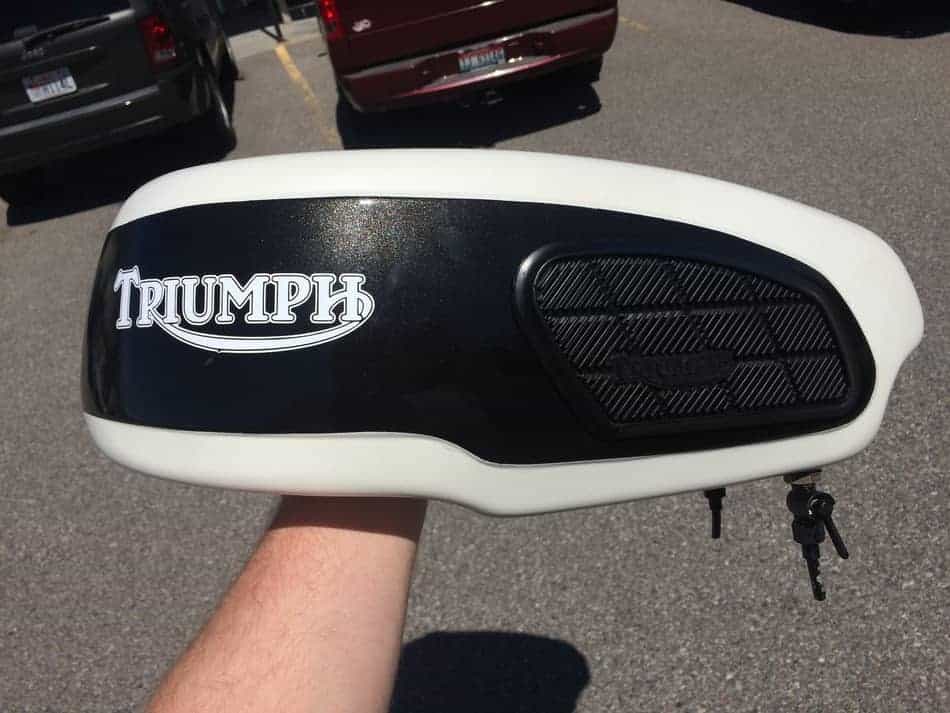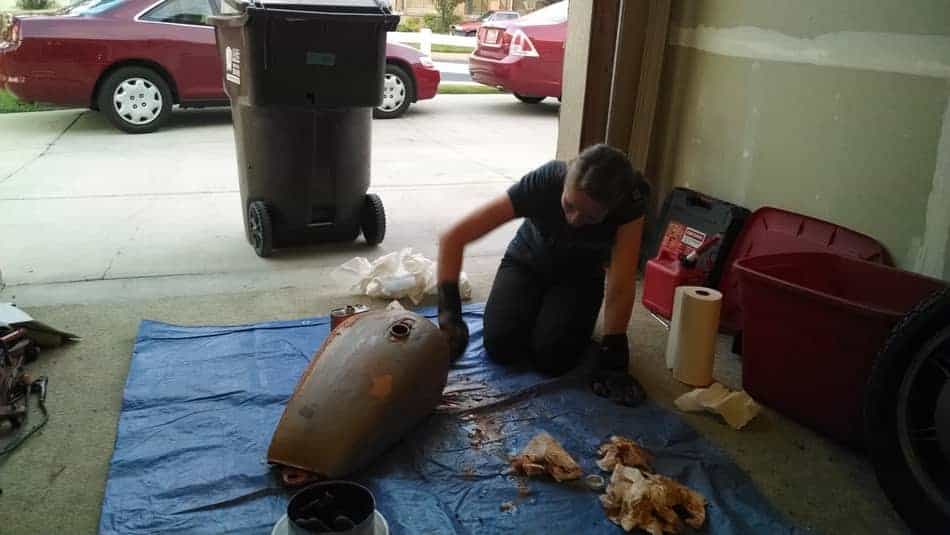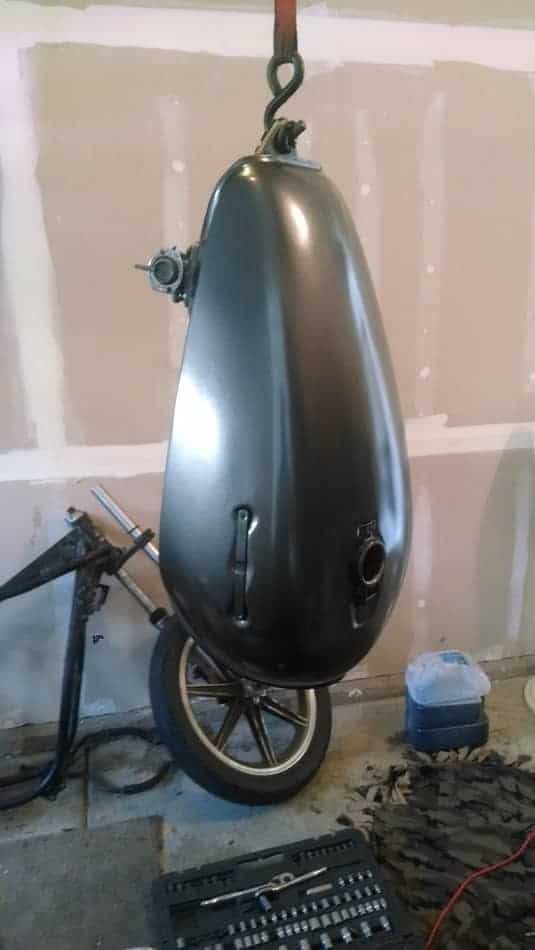
If you’re a motorcyclist who likes to do things yourself, you’ve probably come across the idea of painting or repainting your motorcycle tank. I have restored over a dozen motorcycles and have tried most methods to paint a tank.
So what is the best paint to use on a motorcycle gas tank? The best paint to use on a motorcycle gas tank is Dupli-Color aerosol spray paint. It has proven to give the best results as well as doesn’t show spray lines, it’s easy to use, and costs much less than an HVLP paint sprayer and accommodating equipment.
Many DIYers worry about the quality from a spray can and if they should spend the money on more expensive equipment. Painting a motorcycle tank isn’t as complicated as some may think, but there are a few things to think about before you paint.
Since motorcycle tanks are so round the spray pattern from the can is able to blend perfectly. Since body panels on cars are so large and flat I would NEVER recommend someone using aerosol on a car.
Why Use an Aerosol?
As mentioned before, I have used every method possible to paint a motorcycle tank. I have found the best results from using the Dupli-Color aerosol paint (you can find it here in my list of recommended products).
The first reason I love this product is because of the quality. Many times have I used Dupli-Color and was later asked where I took my tank to get it professionally painted. People are always shocked when I tell them I did it myself with spray paint.
The second thing I love about this product is the cost. You can usually buy a can of this for about $9 – $10 each. I usually buy about three cans for each tank. I usually have some left over, but I’d rather have extra than not enough and run out in the middle of my project.
The spray pattern from these cans is amazing. It has a wide spray pattern and works excellent on rounded surfaces. Because motorcycle tanks are round and not a flat surface, you can get away with using aerosol.
The tip of the Dupli can is removable for easy clean up and is able to rotate 90 degrees when you spray (which is SO useful when you can’t easily move around what you’re painting.) Instead of holding the can sideways and getting uneven spray you just rotate the tip.
The Dupli-Color aerosol spray can is easy to use in hot and cold weather. For a while I lived in northern Utah while I was going to college. I restored motorcycles to pay for my schooling and that included restoring motorcycles in a shed during 7 degree weather. And this paint worked like a charm! No, it’s not recommended to paint when it’s that cold, but it can be done.
Once you’re done with your project there’s very little cleanup at all! Throw the can away and sweep the floor as the spray leaves a little dust on the ground.

Why Not Use a HVLP Paint Sprayer?
You’ll see a lot of professionals and a lot of forums tell you that you’ll need to use an HVLP paint sprayer (or a high volume low pressure paint sprayer) to paint your motorcycle tank correctly. I’ve tried it, and though it yields excellent results, I’d say it’s the same quality as the Dupli-Color. Again, this only holds true for motorcycle tanks, not car panels. Absolutely use an HVLP paint sprayer if you’re painting flat panels.
You absolutely can use a paint sprayer if you have one, but if you don’t, don’t bother getting one. HVLP paint sprayers add a lot of extra stress to the project; if you don’t know what you’re doing then you will easily botch up the paint job.
HVLP paint sprayers are also quite expensive. A decent one goes for around $150 plus you usually need an air compressor, and if you don’t have one of those, that’s another $200. Then you’ll have to add in miscellaneous tools such as renting/setting up a paint booth, replacement cups, air hose, etc. That could be an additional $100. Using an HVLP paint sprayer costs about $450 as compared to $30. I like $30 more.
The clean up after using a paint sprayer isn’t near as easy as using an aerosol can. Once you’re finished with your product, you have to clean up any over spray (as the HVLP paint sprayer sprays with more power). You’ll also need to take it apart to clean it. If you don’t clean it up right away you’ll spend hours or days trying to get it to work correctly the next time you use it.
There are some cheap HVLP paint sprayers (around $15) you can buy from certain hardware stores but I highly advise against these. I’ve tried using them on several occasions and always end up frustrated and having to redo my work. If you are convinced you want to use an HVLP paint sprayer then spend more and get a decent one.
Other Equipment Needed to Paint a Motorcycle Tank
Once you have the paint you need, there’s a few other things you’ll need to make your paint job successful. You’ll also need:
- Safety glasses
- Respirator
- Sandpaper, specifically 80, 150, 220, 300, and 400 grit
- Sandpaper block
- Old sheets and/or newspaper
- Tow strap
- Bondo
- Bondo Scraper
- Green self-etching primer
- 2-part catalyzed clear coat
- Painter’s tape
Make sure to get the 2-part catalyzed clear coat such as the Spray Max 2k High Gloss Clear Coat. If you use a single stage clear coat, any gas dripped on it will eat right through your tank paint down to bare metal. The 2-part clear coat won’t do that.
It’s important you have all of these. You cannot skip using any of these for safety reasons as well as quality reasons. During the many times I’ve painted motorcycle tanks, I am sure to not skip any of these. I’ve come up with some absolutely stunning looking tanks.
I have created a video series about restoring motorcycles and within this series includes detailed videos on how to fix up and paint a motorcycle gas tank. This series also includes other hard-to-tackle components such as carb rebuilds and electrical. I give dozens of tips and tricks that you won’t find anywhere else online. Click here for more information if you’re interested in viewing multiple videos that will help fix up your bike or if you’re interested in completely building your dream motorcycle!
How to Paint a Motorcycle Gas Tank
First, you’ll need to empty the gas out of your tank and completely detach the tank from the motorcycle. You will be handling and carrying your tank around, so make sure there is nothing you’ll trip over so you don’t drop your tank. Don’t think you’ll get a decent paint job while trying to paint the tank while it’s still on the bike.
You don’t always need to completely strip the paint off the tank and get it to bare metal. The only time I completely strip the paint is if the old paint is cracked and peeling up everywhere. The point is to get the base completely smooth and free of blemishes. So if the current paint is still smooth then just do a good sanding, don’t worry about getting down to the bare metal.

The next step is to use bondo or body filler and fill all the small dents and imperfections with the bondo scraper. Follow the instructions on the back of the can and watch some videos of how to do it before you start.
Once the bondo is dry then sand it with the sanding block, NOT with your hands. Your hands aren’t flat, so when you sand bondo without a block then you just end up recreating the original problem, and then you’re back to where you started. You will only get a truly straight edge by block sanding.
Once the tank is perfectly smooth and there are no longer dents you’ll put your first coat of primer on. The first coat of primer is very light, don’t try to totally cover the tank. The second and third coats will cover it completely. Follow directions on the back of the can for best results.
Whether you stripped the paint or plan to paint over the original color, the next step is to wet sand. Using 400 grit sandpaper and a small bowl of water, get the tank totally wet and sand in small circular motions until the tank is perfectly smooth. You don’t want to sand through the primer, you just want to get it smooth. Once it’s totally smooth you’re ready for paint!
You’ll now need to tape anything on the tank that you don’t want painted such as the gas cap, petcocks, frame mounts, etc. It’s okay if you get paint underneath the tank, but don’t spend too much time painting under there as you won’t be able to see it once it’s on the motorcycle. Just make sure that anything that’s going to be visible is sanded and prepped properly.
I have to stress the importance of prep time on the primer and bondo on the tank. Prepping is the most important part of painting. If you have small dents, dimples, air pockets or any kind of imperfection at all it will get WORSE once it’s painted and glossy. Many beginners think “paint will probably cover that once it’s painted.” It won’t. Do it right from the beginning or you’ll just end up redoing it later.
Next, use the tow strap to securely hang the tank from a beam or something in your garage. Sweep the floor really well and wait for an hour for any dust particles to settle. I even use a hose and spray the ground with water before I start painting to ensure that dust gets trapped on the floor and isn’t floating around in the air.
Put on your safety glasses and project respirator. Put down newspaper below the tank and put old sheets over anything in your work space you don’t want to get paint on.
Before you paint, make sure your tank is primed in all one color. If you sanded through the primer during the wet sanding stage, and now a different color is showing on the tank you’ll have to re-prime and re-wetsand. If there are spots of different colors and then you paint the tank, the final color will show up in different shades and look bad. The entire base has to be a uniform color.
One final prep step before you spray your desired color. Get some wax and grease remover from any auto parts store and wipe down the primed tank. After you do this, so not touch the tank again with your bare hands. Your hands have oils on them and can cause serious paint adhesion problems for your tank. After you use wax and grease remover you’ll want to wear latex or rubber gloves from now on in the process.
Once you have all the blemishes gone and your tank is completely primed and dry, now you can start spraying your desired color. Be very conservative with the way you spray. I always do about 3-4 coats and spray lightly to prevent any runs.
If any runs happen, you’ll need to wet sand and prime again. Just like with the primer, your first coat should be very light. The first coat is not going to cover the tank, so be very conservative with how your spray.
When your paint has dried for several hours you’re ready to add the clear coat. The clear coat I suggested is extremely potent and harmful for our lungs, so after you spray each coat you’ll need to leave the area for a few minutes. Spray your tank with clear coat with about 3 -4 coats. Let it cure for about 24 hours before touching it.
I always recommend the 2 part 2K clear coat cans (you can find it here in my list of recommended products). They have a big red button on the top of them that you use to puncture a small hole inside the can, then a chemical reaction starts happening inside.
The reaction will cause the clear coat to start slowly hardening. If you don’t use this type of clear coat on your tank then will ruin the paint quickly. It’s much harder, glossier, and superior to all other aerosol clear coats. It costs between $20-$30 per can but you will only need one can.
Voila! You have a beautiful gas tank to put on to your motorcycle! Don’t forget to notice all the looks and comments about how good your tank looks. I know it’s tempting to immediately want to put the tank back on the motorcycle, but only put it on once you’re done with everything else or you’re going to scratch it.
Click here to see my list of other recommended upgrades for your motorcycle.

Related Questions
Do I need to add clear coat when I paint my motorcycle frame? This entirely depends on the type of paint you use. It’s best to look on the back of the paint container and read the instructions. Clear coat is not unheard of for a frame, but most don’t add it. Click here to see my article about how to paint a motorcycle frame without removing the engine.
How do I remove rust from inside the motorcycle tank? There are several ways to remove rust, some ways I’ve come to find to be most effective is using muriatic acid or vinegar and let it sit over night. If you have large amounts of rust, try adding a few handfuls of gravel inside the tank with some water and give it a good shake.
